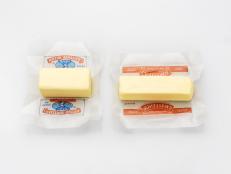How to Tell If Yogurt Is Bad (Without, Uh, Tasting It)
Plus, how to store yogurt so it lasts longer.

annata78/Getty Images
By Layla Khoury-Hanold for Food Network Kitchen
Layla Khoury-Hanold is a contributor at Food Network.
Yogurt is a food product that’s produced by the bacterial fermentation of milk, so it can be hard to tell if it has gone bad. To help us learn how to tell if yogurt is bad, we consulted Toby Amidor, MS, RD, CDN, FAND, award-winning nutrition expert and Wall Street Journal best-selling author of Diabetes Create Your Plate Meal Prep Cookbook, and Dana Angelo White, MS, RD, ATC, foodnetwork.com contributor, cookbook author and owner of Dana White Nutrition, Inc.
Does Yogurt Go Bad?
The short answer is yes, yogurt can go bad. “Yogurt is a pretty stable food, but it can go bad due to molds, yeast or slow growing bacteria. This spoilage is likely to happen if the yogurt isn’t kept refrigerated at 40-degress or below,” Amidor says. “Because of the added sugars, flavored yogurts tend to spoil sooner compared to their plain counterparts when not stored at the proper temperature.”
White points out that all perishable foods that require refrigeration have the potential to spoil. “In the case of yogurt, the recommended shelf life is usually two weeks in the fridge and two months in the freezer, according to the USDA,” she says. “There is no guarantee whether the yogurt would be edible or not before or after this time frame, so it’s always good to check for any off odors or discoloration and when in doubt, throw it out.”
How to Store Yogurt So It Lasts the Longest
Amidor shares that best practice for increasing the shelf life of yogurt is to store it in the refrigerator at or below 40 degrees F. “If you remove a larger tub of yogurt and don’t plan on using the entire tub in one sitting, then take what you need with a clean spoon, cover, and put the tub back in the refrigerator as soon as possible,” Amidor says. “You want to minimize the time the yogurt spends outside of the refrigerator, and it should never be left out of the refrigerator for over two hours.” White adds that when storing yogurt in the freezer, the optimal temperature should be at 0 degrees F and the yogurt should be consumed within two months of freezing.

Arx0nt/Getty Images
What to Know About Yogurt’s Sell-By Date
Generally, manufacturers put sell-by-dates on food to indicate when the product will remain at optimum freshness, not to indicate spoilage. “It is typically safe to eat yogurt past its sell-by-date as long as there are no indications of spoilage, like an off odor or mold growth,” Amidor says. “It is best to eat the yogurt within 7 to 14 days after it is opened in order to reduce the risk of mold or yeast growth.”
How to Tell Yogurt Is Bad
There are several things to look for that signals if yogurt has gone bad. Here’s what to check for:
- Mold or yeast growth: Amidor reports that this can be green, blue, gray or white in color. “If you see any strange color that is not supposed to be there, then discard the yogurt,” she says.
- Excessive clumping or curdling: yogurt should have a smooth texture, so a clumpy or curdled consistency is a sign of spoilage and a tip-off to throw the yogurt away.
- Excessive liquid: Yogurt typically has a small amount of liquid on its surface (which can be poured off if preferred). “But if the container of yogurt is past the sell-by-date or has been open for several days, you may observe a lot of liquid at the top which can indicate spoilage,” Amidor says.
- Smell: If the yogurt smells rancid or off, then discard it. “Spoiled dairy products may appear to be curdled with an increasingly sour or musty smell,” White says.
What Happens If You Eat Yogurt that Has Gone Bad?
While there’s no guarantee that eating spoiled yogurt will make you sick, it’s best to avoid the risk. “Eating spoiled yogurt and dairy products can cause stomach upset and possibly nausea, vomiting and diarrhea, depending on how much you eat,” White says. “In cases where the yogurt is very spoiled, the bad taste would likely deter people from eating large amounts of it.”
Related Links:































































